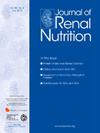维持性血液透析患者甲状旁腺激素低的营养和炎症方面--一项纵向研究。
IF 3.2
3区 医学
Q2 NUTRITION & DIETETICS
引用次数: 0
摘要
背景:低血清甲状旁腺激素(PTH)是一种公认的非动力性骨病标志物,其特点是增加维持性血液透析(MHD)患者的发病率和死亡率。鉴于已知 PTH 与营养不良-炎症综合征之间存在横断面关联,我们旨在研究 PTH 与低 PTH MHD 患者的营养和炎症参数变化以及临床预后之间的纵向关联:这项历史性前瞻性纵向研究分析了一个血液透析中心的临床数据库,其中包含 2007-2020 年间接受治疗的 459 名 MHD 患者(平均年龄为 71.4±12.9 岁,171 名女性)的医疗记录。在 0、6、12、18、24、30 和 36 个月时记录了骨转换、营养和炎症指标水平,随后又进行了中位数为 24 个月的临床观察。根据以往使用维生素 D 类似物和/或钙传感受体激动剂的情况,研究参与者被分为治疗相关组和疾病相关组。采用线性混合效应模型对基线人口统计学和临床参数进行调整:在 459 名 MHD 患者中,81 人(17.6%)的 PTH 低于 150pg/ml。其中,30 名患者的低 PTH 与治疗有关,51 名患者的低 PTH 与疾病有关。与疾病相关组相比,基线时与治疗相关的低 PTH MHD 患者患糖尿病的比例更高。在线性混合效应模型中,随时间推移,PTH的增加与碱性磷酸酶(ALP)和C反应蛋白(CRP)水平的降低以及血红蛋白和白蛋白的增加有关,但与随访3年的老年营养风险指数(GNRI)无关。两组的存活率没有差异,但疾病相关组因骨折住院的风险更高(HR 4.04,95% CI 1.51-10.8)。在多变量模型中加入CRP或ALP后,这种关联的统计学意义消失:结论:MHD患者血清PTH过低的原因不同,表现也不同。这种关联取决于炎症。我们的研究结果应在更大规模的流行病学研究中得到验证。本文章由计算机程序翻译,如有差异,请以英文原文为准。
Nutritional and Inflammatory Aspects of Low Parathyroid Hormone in Maintenance Hemodialysis Patients—A Longitudinal Study
Background
Low serum parathyroid hormone (PTH) is an accepted marker for adynamic bone disease which is characterized by increased morbidity and mortality in maintenance hemodialysis (MHD) patients. In light of the known cross-sectional associations between PTH and malnutrition-inflammation syndrome, we aimed to examine the longitudinal associations between PTH with changes in nutritional and inflammatory parameters and clinical outcomes in MHD patients with low PTH.
Methods
This historical prospective and longitudinal study analyzed a clinical database at a single hemodialysis center, containing the medical records of 459 MHD patients (mean age of 71.4 ± 12.9 years old, 171 women), treated between the years 2007-2020. Bone turnover, nutritional and inflammatory marker levels were recorded at 0, 6, 12, 18, 24, 30, and 36 months followed by a median of 24 additional months of clinical observations. According to previous use of vitamin D analogs and/or calcium-sensing receptor agonists, the study participants were divided into treatment-related and disease-related groups. A linear mixed effects model was adjusted for baseline demographics and clinical parameters.
Results
Of 459 MHD patients, 81 (17.6%) had PTH lower than 150pg/mL. Among them, 30 patients had treatment-related and 51 had disease-related low PTH. At baseline, MHD patients with treatment-related low PTH had a higher rate of diabetes compared to the disease-related group. In a linear mixed effects model, increased PTH over time was associated with decreased levels of alkaline phosphatase and C-reactive protein and with increased hemoglobin and albumin, but not the geriatric nutritional risk index at 3-year follow-up. The survival rate did not differ between the groups, with the risk of hospitalizations due to fractures being higher (HR: 4.04 with 95% CI: 1.51-10.8) in the disease-related group. Statistical significance of this association was abolished after adding C-reactive protein or alkaline phosphatase to the multivariate models.
Conclusions
Low serum PTH in MHD patients behaves differently depending on its cause, with a higher risk of fractures in the disease-related group. This association is dependent on inflammation. Our results should be verified in larger epidemiological studies.
求助全文
通过发布文献求助,成功后即可免费获取论文全文。
去求助
来源期刊

Journal of Renal Nutrition
医学-泌尿学与肾脏学
CiteScore
5.70
自引率
12.50%
发文量
146
审稿时长
6.7 weeks
期刊介绍:
The Journal of Renal Nutrition is devoted exclusively to renal nutrition science and renal dietetics. Its content is appropriate for nutritionists, physicians and researchers working in nephrology. Each issue contains a state-of-the-art review, original research, articles on the clinical management and education of patients, a current literature review, and nutritional analysis of food products that have clinical relevance.
 求助内容:
求助内容: 应助结果提醒方式:
应助结果提醒方式:


